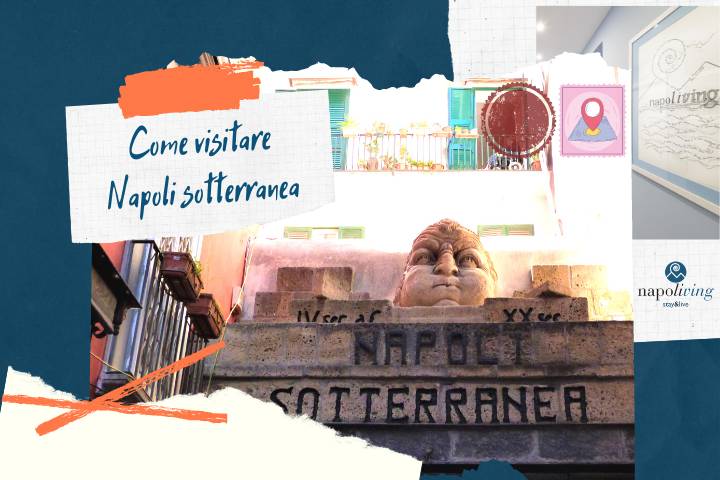Naples shows off a thousand shades of colour: sea, sky, meadows, and sun.
It is a city to be discovered, where every corner, every wall and every ‘sanpietrino’ (the little square cement blocks paving several ancient Neapolitan streets) tells a story.
However, the charm of the city is not only open air, as Naples’ subsoil can thrill as much as the historic buildings and museums.
Here there are hidden places talking about historic events and testifying Neapolitan people’s courage.
One of the most evocative routes, hidden in the sunlight, is Napoli Sotterranea (underground Naples), an urban substrate rich in history, one of a kind.
When in Naples, add it to your to-do-list, and experience a 2400-years journey from the Greek age to the modern era, 40 metres underground through tunnels and cisterns.
Di cosa parliamo in questo articolo
How to get to Underground Naples
The entrance is on Via dei Tribunali, right next to the Basilica of San Paolo Maggiore, in Piazza San Gaetano, in the heart of the city centre, and it is marked by white and blue flags.
Remember that this is the only Official Authorized Route of Napoli Sotterranea; in fact, high safety standards are guaranteed.
From Napoliving rooms, get on at Università metro station (2 minutes walk) and get off at Piazza Dante stop (three stops away).
From there, walk towards Port’Alba and go straight on via San Pietro a Maiella.
After about 600 metres, you will find the entrance on your left.
Napoli Sotterranea: history
This evocative itinerary was born around the IV century BC, when the Greeks began digging to extract the tuff necessary for the construction of Neapolis.
The excavations for the extraction reached up to Monte Somma, near the province of Volla, where they found water to connect with the cisterns.
Thanks to a series of long and narrow tunnels, which made the flow from one cistern to another faster, the underground became an aqueduct that supplied the city of Naples.
Later, during the Augustan era, the Romans expanded this aqueduct by 460 km2, with the water coming from the mouth of the Serino, in Avellino.
From there, it was channelled in 3 main directions:
- The area of Naples, Casalnuovo and Acerra;
- The area of Ercolano, Pompeii and Stabia;
- The Piscina Mirabilis in Bacoli, a tank of about 12,000 m3.
Unfortunately, in 1885 the contamination of water due to the cholera epidemic forced the Kingdom of Italy to decree the definitive closure of the aqueduct, and the undergrounds became an illegal landfill until 1942.
The Second World War
In 1942, during the Second World War, Naples needed anti-aircraft shelters, therefore the Genio Civile – a peripheral state body with a regional function – decided to use the underground, making some the necessary changes.
The first step was the construction of stairs, since the only access routes to the aqueduct were wells; then, it took covering all the waste with soil.
This means that today the original floor of Napoli Sotterranea is 4 metres below.
Clearly, in order to prevent the bombs from entering them, all the wells were closed, except for the one under the notary archive of the Basilica of San Paolo Maggiore, meant to provide oxygen to the people who would take refuge underground.
The well was chosen according to the belief that churches were immune from bombing.
They were not!
Both the Basilica of San Paolo Maggiore and the Monastery of Santa Chiara were bombed. Unfortunately!
When you walk the itinerary of Napoli Sotterranea, you will also have the chance to admire artifacts from the time it was a refuge, such as toys and cots found at a depth of 36 metres.
Yes, no misreading: once inside, you go down from 36 to 40 metres!
Napoli Sotterranea and the “pozzari”
When the underground was an aqueduct, both public and private cisterns were made.
The nobility used servants, called “pozzari”, to keep them clean.
Since pozzari were not paid for it, they started to take what they deserved by entering ad robbing the nobles’ houses through the wells.
This practice inspired the Neapolitan legend of the “Munaciello”, a little monk, a legendary spirit, who appears in homes and enjoys making things disappear.
You will arrive at a tunnel 50 cm wide and 50 m long, through which you can access the most beautiful cisterns, flooded to recall the original aqueduct.
The tour around these pools, from where the Neapolitan people drew water with a pot tied to a rope, is the original walkway used by pozzari.
Do know that the access to this area through the tunnel is done with candles, as it is very dark.
If you are claustrophobic, you can wait at the entrance of the tunnel and then rejoin the guide and the others as soon as they have finished visiting this area.
After this suggestive spot, you will arrive at the last cistern under the cloister of San Gregorio Armeno, once communicating with the church of San Lorenzo Maggiore, a place where monks and nuns could meet.
The incorporated Greek-Roman theatre
At the end of the tour you will be back to the surface, but wait, because your experience has not finished yet! The second part of the guided tour is about to start, as you’re going to visit the remains of the incorporated Greek-Roman theatre.
The entrance is in Piazza San Gaetano, the agora of the Hellenic civilization and, later, the Roman forum.
The existence of a large theatre behind the forum emerged from some writings by the Roman poet Publio Papinio Stazio.
For this reason, some archaeologists of the association decided to monitor the area, and they eventually discovered that in a “vascio” – typical Neapolitan house at street level – there were some arches.
By removing the plaster, they found an “opus latericium“, a masonry made with sun-baked bricks, typical of Roman buildings.
The lady living in that house said that the same type of masonry was also present in her cellar, so archaeologists understood that they were in front of the dressing rooms used by the actors in ancient time.
There was great excitement for this discovery, even though most of the theatre is no longer visible since it is incorporated into private homes.
There are houses containing the parterre and part of the terraces, as theatre was used as basement.
The very last part of the tour is in the “summa cavea” of Nero’s Teathre, the highest area of the terraces which, until few years ago, was incorporated into a carpentry.
An exhibition of nativity scenes (“presepi”) from the 1700s is set up inside with a perfect synergy: the representations are Roman ruins in scale, so you can admire the miniaturized remains in the shadow of the original ones of the theatre.
Napoli Sotterranea: timetables and tickets
Napoli Sotterranea is open every day from 10 am to 6 pm. Guided tours in Italian are set every hour, while guided tours in English are every two hours.
Reservations are required for tours in French, Spanish and German.
The tour lasts about 1 hour and a half; the ticket price is €10 per person.
Our advice is to wear comfortable shoes and to bring a sweatshirt in summer to put on if necessary, for the underground path is very wet.
We hope to have inspired you to discover this historic and evocative place, and we wait for you in Napoliving to give you all the information you may need.

Insegnante di lingua e letteratura inglese per la scuola secondaria, traduttrice e correttrice di bozze. Coltivo con devozione e premura l’interesse per la cultura giapponese, e nutro tutte le mie altre creature con la stessa cura: libri, film, musica. Viaggio tanto, ma resto figlia di Partenope.

